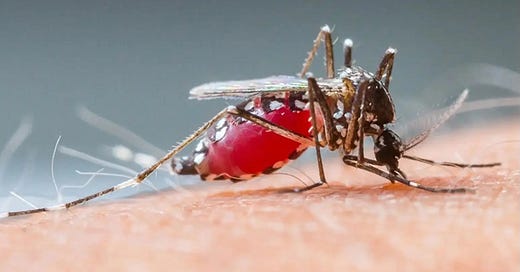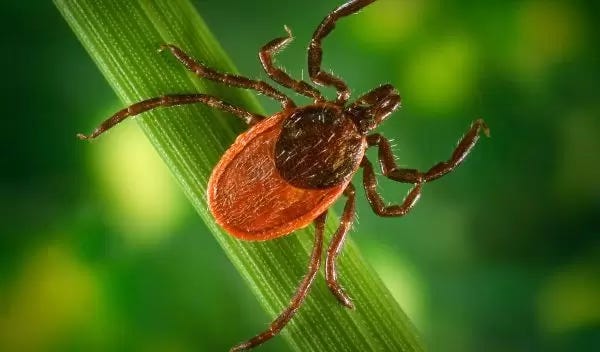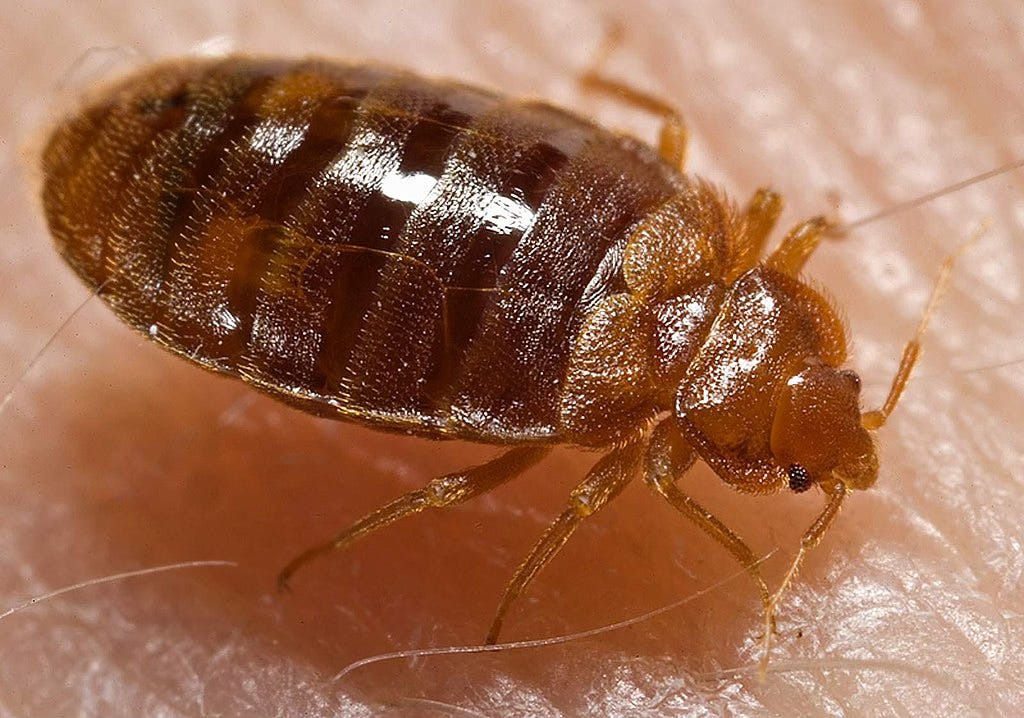UPDATED: July 2, 2025
Welcome to the Healthy Living Is Good Medicine Newsletter, a totally free, health education publication covering a wide variety of topics, with original articles intended to help people lead healthier and more fulfilling lives.
This Post follows my previous article about dog bites and updates an older article about some dangerous tiny critters that might be lurking in your own backyard, or in a neighborhood near you.
The world's most dangerous animal is a tiny insect that transmits diseases responsible for the deaths of up to a million people every year. A major perpetrator of vector-borne diseases, mosquitoes are a widespread scourge for mammals, birds, reptiles, and amphibians. It is only the females of specific mosquito species that feed on blood.
The Deadly Threat of Mosquitoes
Climate change and rising temperatures have rapidly expanded the range of disease-carrying mosquitoes throughout the United States. There have been locally transmitted cases of malaria in Florida, Maryland, Arkansas, and Texas, dengue in California, Florida, Hawaii, Texas, and Arizona, chikungunya in Florida and Texas, and Zika in Florida.
While a warmer climate increases the number of suitable breeding habitats, global trade has introduced new species, and urbanization has contributed more breeding sites. This synergy has created a recipe for increased mosquito colonization and elevated the disease transmission risk.
As one version of history goes, Hawaii’s first mosquitoes were deliberately introduced by prudish Christian missionaries in order to force the natives to wear clothes. However, Hawaiians love “talking story” and have been known to avoid letting the truth get in the way of a good tale.
Previously free of biting insects, the Culex quinquefasciatus mosquito was the island nation’s first invasive species. Believed to have been introduced in 1826 via larvae in a ship’s drinking water, this carrier of avian malaria has since been decimating Hawaii’s unique bird populations. As a former long-term resident of the state, I take a personal interest in such things.
The Aloha State’s current mosquito population is now more diverse and has the potential to transmit diseases such as dengue, chikungunya, and Zika, if they are brought to the islands by infected travelers. Consequently, the Hawaii Health Department now asks infected individuals to protect themselves from further mosquito bites during their first two weeks in Hawaii in order to prevent local spread.
West Nile virus (WNV) is the most common and widespread mosquito-borne illness in the United States, with 2,566 cases reported in 2023. Less than one percent of those infected develop severe symptoms such as meningitis, encephalitis, paralysis, or other neurologic findings with a 10 percent mortality. The well-known infectious disease authority, Dr. Anthony Fauci, was hospitalized for almost a week with WNV, after being bitten by a mosquito in his backyard. In a recent interview, Fauci said he thought he might die or suffer permanent brain damage.
The more deadly Eastern equine encephalitis (EEE) virus, also spread by mosquito bites, is causing panic in the northeastern U.S. and has just made its way into Canada. It’s estimated fatality rate is 50-75%, and survivors often have persistent neurological complications. St. Louis encephalitis (SLE) is less dangerous, but can still cause meningoencephalitis. It has a 5-20 percent mortality rate. An emerging neuroinvasive, mosquito-borne disease, caused by the Cache Valley Virus (CVV), has recently been reported in Arkansas.
Oropouche virus infections have risen significantly across Latin America and the Caribbean, affecting American travelers. Transmitted through the bite of infected arthropods, the disease has found permissive environments where it has spread through the bites of midges and can be carried from rodents to humans by Aedes and Culex mosquitoes. The rapid increase in cases has been attributed to climate change, deforestation, and urbanization.
I have a had personal experience with mosquito-borne viruses. An untyped encephalitis virus, harbored in a sea bird colony and transmitted by a mosquito bite, nearly cost me my life while I was in the Bahamas studying marine biology. Fortunately, the U.S. Coast Guard was able to helicopter me to Miami for treatment.
Many years later I learned that the U.S. Army had funded a classified project through the Smithsonian Institute. The research program involved studying the migratory routes of pelagic seabirds. It appears that the government’s interest was in the possible use of migratory birds to carry Q-fever bacteria and some viruses for biological warfare purposes.
A 2022 study found that some people are a hundred times more likely to be bitten by the female Aedes aegypti mosquito due to the odor produced by high levels of carboxylic acids on their skin. The heightened attractiveness may be due to differences in the composition of people’s skin microbiome.
As with most dangerous encounters, prevention is key. This WaPo article answers the most frequently asked questions. For an excellent look at mosquito population control, see Dr. McCormick’s Post:
Ticks
If the serious risk of mosquito-borne illnesses are not enough for you to take precautions when venturing outdoors, consider that the U.S. has also seen a steep rise in diseases transmitted by ticks over the past 50 years. In a recent report, the surge in tick-borne diseases has been deemed a significant public health threat. As with mosquitoes, some people seem to be tick magnets, while others have no tick appeal. Fortunately, I am among the latter group.
Ticks can transmit the bacteria that cause Lyme disease, ehrlichiosis, Rocky Mountain spotted fever, relapsing fever, anaplasmosis, tularemia, and Q fever; the Powassan, Heartland, and Colorado tick fever viruses; and the babesiosis parasite. There are other tick-borne diseases such as relapsing fever caused by bacteria, and the alpha gal syndrome, caused by the introduction of an allergenic sugar molecule. The tick-borne encephalitis virus is endemic in parts of Europe and Asia, and its infections are vaccine-preventable.
Tick-born infections are preventable. Ticks feed most actively during the warmer months, but tick bites can occur year-round. Reducing your exposure to ticks is your best defense against tick-borne diseases. Ticks live mainly in high grass, brush, and in the leaf litter of wooded areas, but pets can bring them into your home. They are also found in suburban neighborhoods. When hiking, stay on trails and try to avoid contact with vegetation.
Treat clothing with products containing 0.5% permethrin, and apply insect repellents containing DEET or picaridin to your skin. When you're back home, check your clothing and skin for ticks. Placing dry clothes in a dryer on high heat for 10 minutes will kill any ticks. Showering within two hours of exposure has been shown to reduce the risk of some tick-borne diseases. Ticks can be carefully removed from the skin using splinter-removal tweezers or forceps. The CDC has more information on tick risk management.
As an expert in the subject to tick-borne diseases, Dr. Richard Horowitz has written an in-depth article about Ehrlichia and Anaplasma infections, and a number of articles covering Babesia, Bartonella, the Powassan virus, and Lyme disease. If you have experienced any of these diseases, I recommend reading more about them.
Some good news is that a phase 2 clinical trial of a Lyme disease vaccine has found significant efficacy for people who are five to 65 years of age. The investigational VLA15 vaccine is seen as an important advance in the prevention of Lyme borreliosis. It covers a broad spectrum of Borrelia burgdorferi serotypes (the infecting organism) and has a favorable safety profile. On the horizon is an antibiotic that will be more effective against the disease. A recent study of piperacillin has shown promising results.
According to a new report, it is estimated that tens of thousands of people in the U.S. each year develop Lyme infection-associated chronic illness. They develop chronic fatigue, recurring pain, cognitive dysfunction, and/or sleep disturbances, despite receiving the currently recommended antibiotic treatment. This syndrome is distinct from known complications of Lyme disease such as arthritis and myocarditis. Much like Long-COVID, this chronic condition needs to be taken seriously, but the anti-science agenda of the current administration has cut NIH funding. As a result, tick-borne disease research will not be getting the attention that it needs.
Something I’ve recently learned about tick bites is that some people can have life-threatening anaphylactic reactions if they develop an allergy to enzymes in tick saliva such as hyaluronidase, which breaks down the skin. Tick saliva also contains anticoagulants, immunosuppressants, and cement-like substances that helps the tick attach firmly to its host. These proteins are foreign to the human immune system, and can thus act as allergens.
Sandflies
There’s another tropical disease called cutaneous leishmaniasis that is spreading in Texas, according to a 2018 report. Disease-causing protozoans are harbored by rodents (“reservoir”) and transmitted to humans (“host”) by female sandflies (“vector”). These blood-sucking insects are about a quarter of the size of a mosquito and can inflict a painful bite. Sandflies are currently found as far north as Ohio, and their range is expected to further expand due to global warming.
Leishmania mexicana, the parasite that produces this disease, has a complex life cycle alternating between insects and mammals. Infection can produce a persistent ulcerating skin lesion at the site of the bite. Because available treatments can be worse than this disease, an ounce of prevention can pay big dividends. In areas where leishmaniasis has become endemic, such as the Gulf of Mexico region, keeping the skin covered and using an insect repellant such as DEET is advised during the hours from dusk to dawn.
Fleas, Lice, and Other Bloodsuckers
“Big fleas have little fleas upon their backs to bite them,
And little fleas have lesser fleas, and so ad infinitum.”
~ Augustus De Morgan, 1872
Although rare, bubonic plague is transmitted via flea bites from wild rodents to humans. Nationally, cases average about seven a year. Body lice can transmit several diseases, including endemic typhus, trench fever, and louse-borne relapsing fever. These diseases are the result of microorganisms that the lice carry and transmit through their feces while feeding upon human hosts. Fortunately, the bites of head lice and bed bugs are not known to transmit any human diseases. However, scratching the itch caused by their bites could lead to bacterial infections.
This article has focused upon biting insects and arthropods encountered in the United States. Although suggested by some of my readers, I’ve avoided mentioning other repugnant blood-suckers, such as vampire bats and the Internal Revenue Service.
Foreign travel can expose people to an even broader range of vector-borne diseases. These include malaria, Zika virus infection, Chagas disease, yellow fever, and some really nasty diseases caused by parasitic worms, including filariasis and schistosomiasis. Tsetse flies can deliver a very painful bite, something I experienced during my travels in East Africa. Fortunately for me at the time, only one in ten flies carried the blood parasite that causes trypanosomiasis (aka “African sleeping sickness”).
Immunization, prophylactic medications, and mosquito netting are essential when traveling to tropical and sub-tropical regions with endemic tropical diseases. Please stay informed about local risks, and be safe out there!
― ― ―
This post can be updated at any time. Please check back here again to find the most up-to-date version of this article.
You can find many more articles about Healthy Living in my Post Archive.
Please share my Website Link with others via your social media accounts. You can help your friends and followers become healthier by suggesting that they subscribe to my totally free Newsletter.








